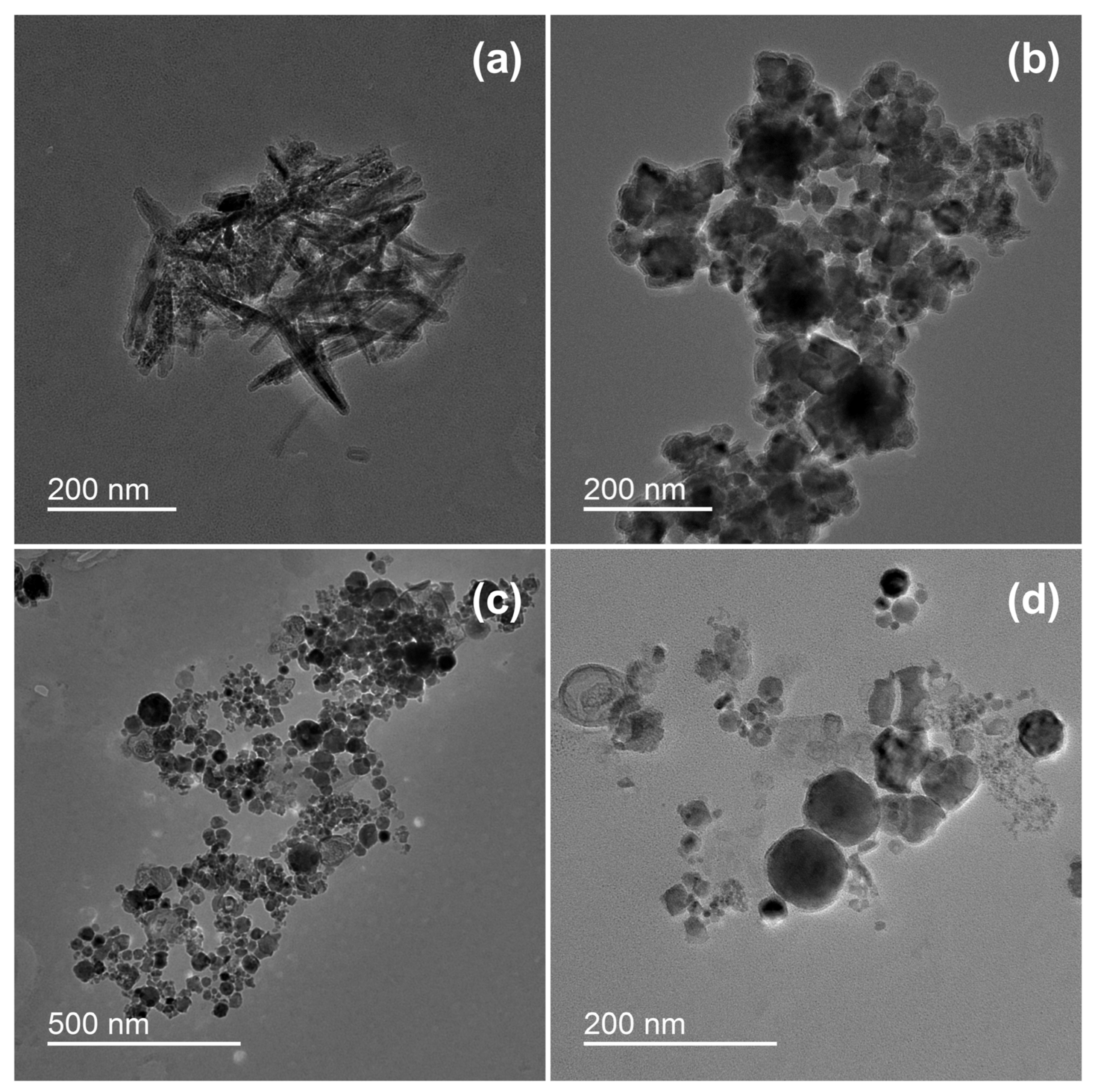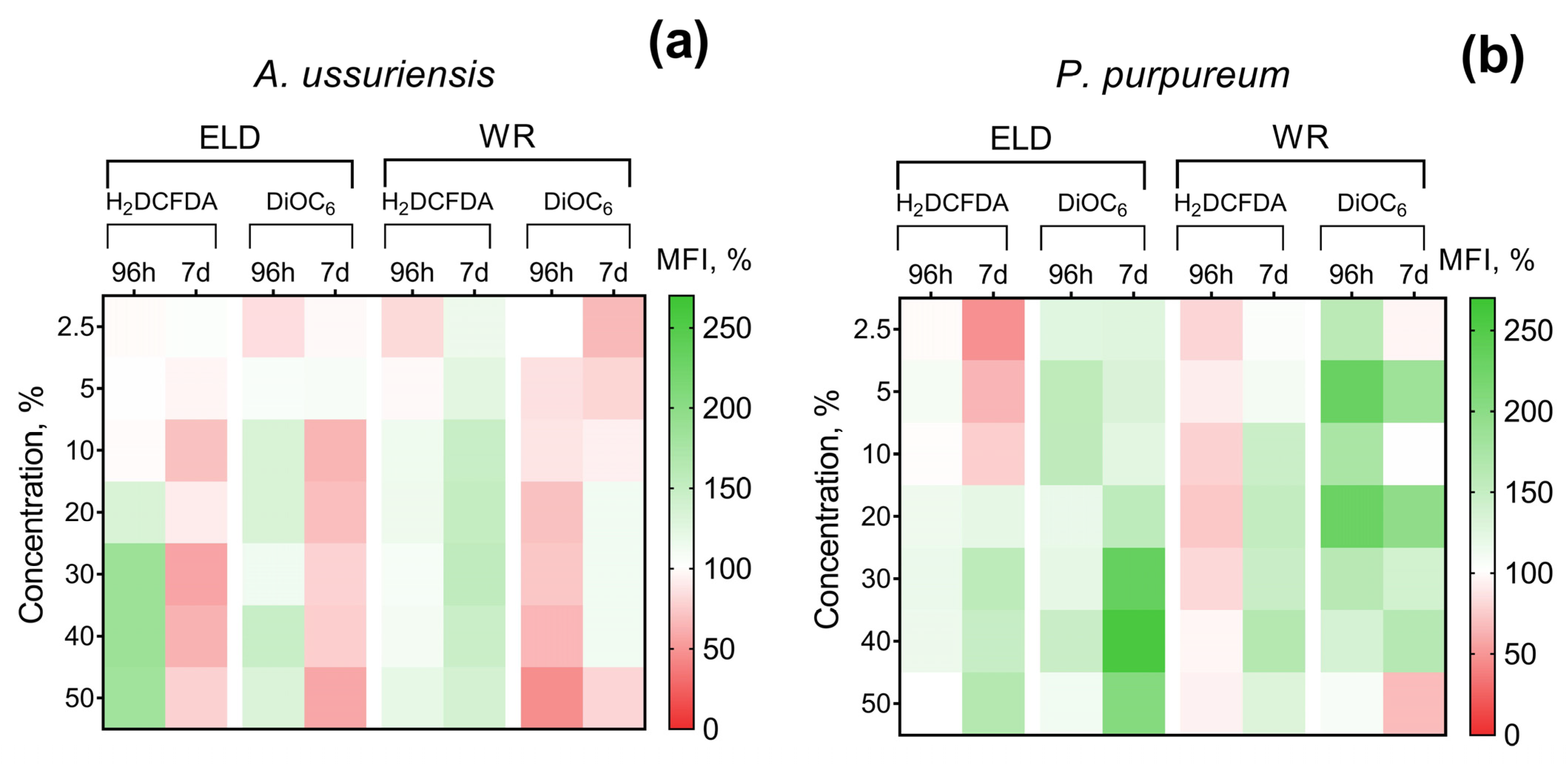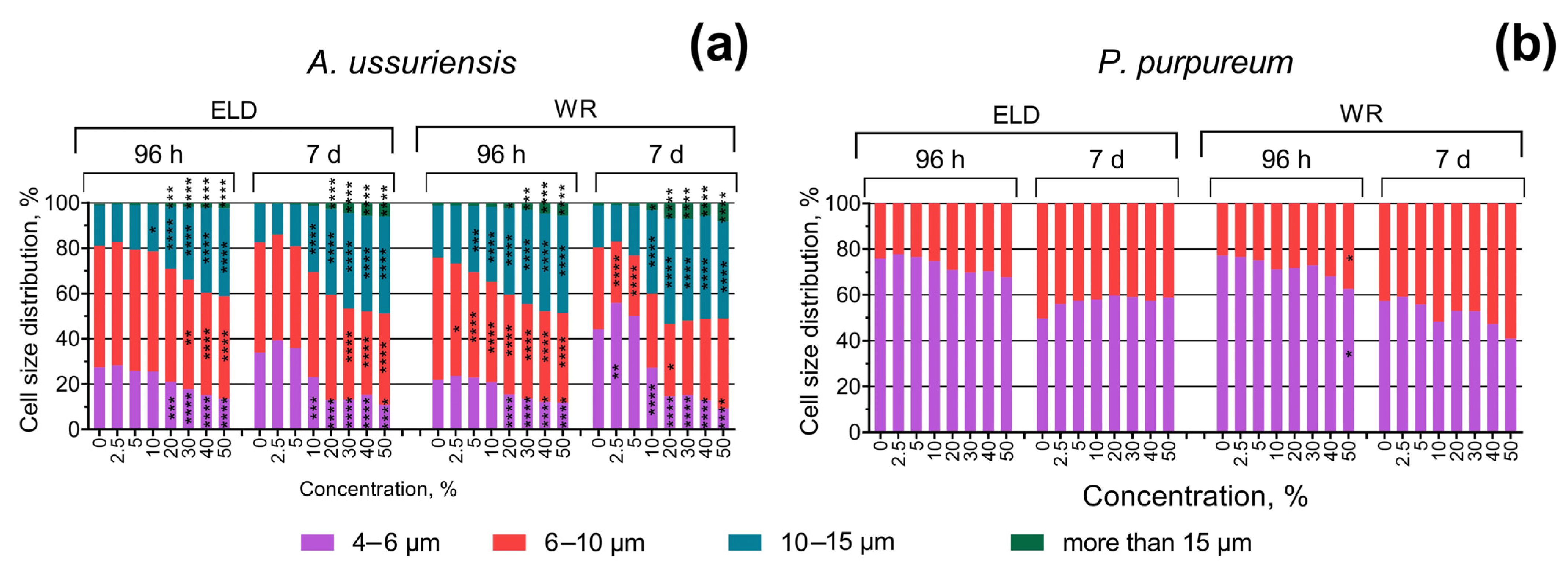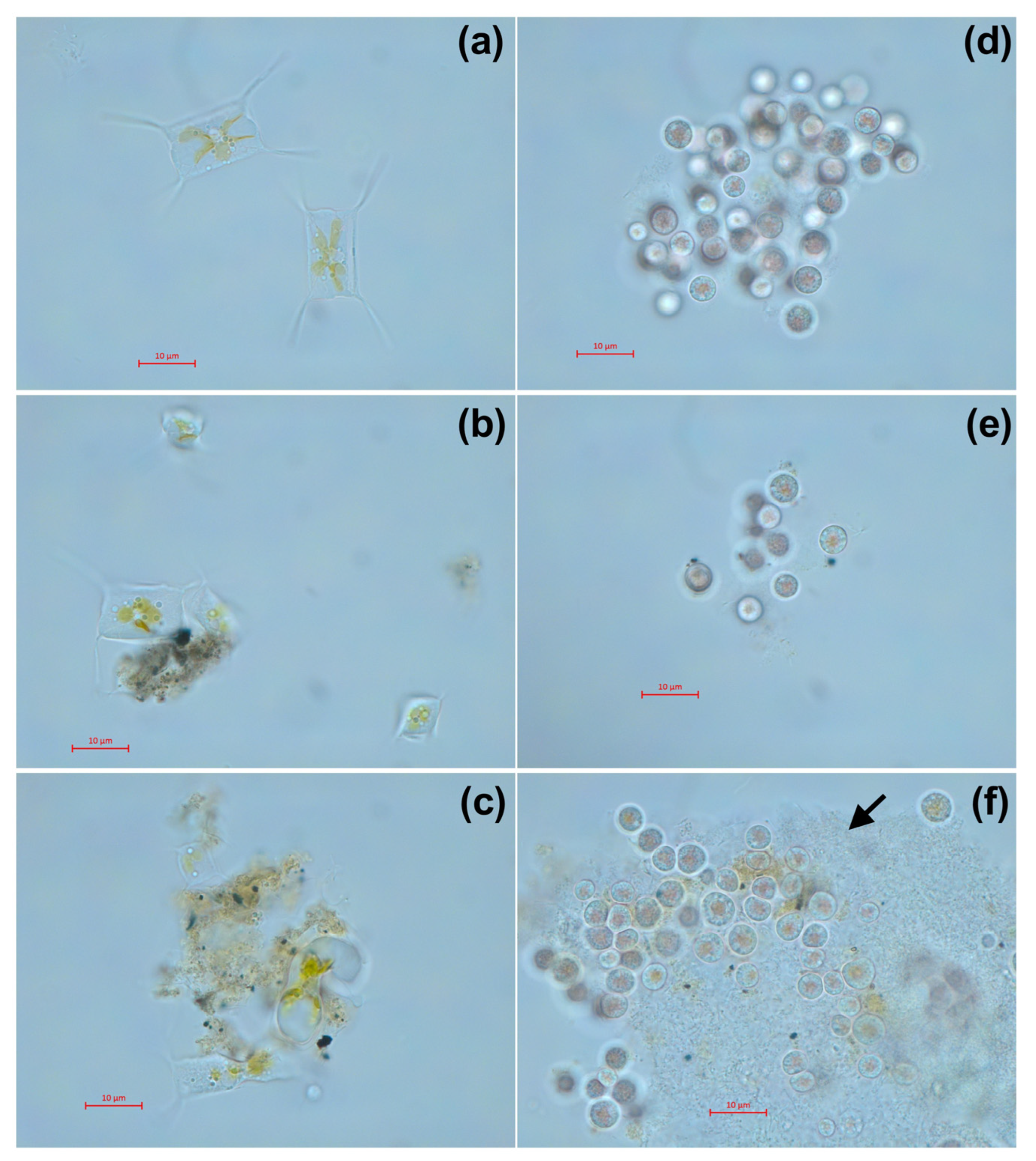The Impact of Metal-Based Nanoparticles Produced by Different Types of Underwater Welding on Marine Microalgae
Abstract
:1. Introduction
2. Materials and Methods
2.1. Sample Preparation and Characterization
2.2. Microalgae Cultures and Exposure
2.3. Flow Cytometry Analysis
2.4. Microscopic Observation
2.5. Statistical Analysis
3. Results
3.1. Sample Characterization
3.2. Toxicity Bioassay
4. Discussion
Supplementary Materials
Author Contributions
Funding
Institutional Review Board Statement
Informed Consent Statement
Data Availability Statement
Acknowledgments
Conflicts of Interest
References
- Surojo, E.; Putri, E.D.W.S.; Budiana, E.P. Recent developments on underwater welding of metallic material. Procedia Struct. Integr. 2020, 27, 14–21. [Google Scholar] [CrossRef]
- Verma, K.; Garg, H.K. Underwater welding-Recent trends and future scope. Int. J. Emerg. Technol. 2012, 3, 115–120. [Google Scholar]
- Łabanowski, J.; Fydrych, D.; Rogalski, G. Underwater Welding—A review. Adv. Mater. Sci. 2008, 3, 2478. [Google Scholar] [CrossRef]
- Zhang, M.; Han, Y.; Jia, C.; Dong, S.; Maksimov, S.; Wu, C. Process Stability, Microstructure and Mechanical Properties of Underwater Submerged-Arc Welded Steel. Metals 2021, 11, 1249. [Google Scholar] [CrossRef]
- Tomków, J.; Fydrych, D.; Rogalski, G.; Łabanowski, J. Temper bead welding of S460N steel in wet welding conditions. Adv. Mater. Sci. 2018, 18, 5–14. [Google Scholar] [CrossRef] [Green Version]
- Zhu, J.; Jiao, X.; Wang, K.; Gu, Y.; Cai, Z. Development of Underwater Laser Wire-Filling Welding Device and Welding Maintenance Technology for Offshore Oil and Gas Pipeline. In Proceedings of the Offshore Technology Conference Asia, Kuala Lumpur, Malaysia, 2–6 November 2020. [Google Scholar]
- Parshin, S.; Levchenko, A.; Wang, P.; Maystro, A. Mathematical analysis of the influence of the flux-cored wire chemical composition on the electrical parameters and quality in the underwater wet cutting. Adv. Mater. Sci. 2021, 21, 77–89. [Google Scholar] [CrossRef]
- Moreno-Uribe, A.M.; Bracarense, A.Q.; Pessoa, E.C. The effect of polarity and hydrostatic pressure on operational characteristics of rutile electrode in underwater welding. Materials 2020, 13, 5001. [Google Scholar] [CrossRef]
- Anand, A.; Khajuria, A. Welding processes in marine application: A review. Int. J. Mech. Eng. Robot. Res. 2015, 2, 215–225. [Google Scholar]
- Golbabaei, F.; Khadem, M. Air pollution in welding processes—Assessment and control methods. In Current Air Quality Issues; InTech: Rang-Du-Fliers, France, 2015; pp. 33–63. [Google Scholar]
- Gomes, J.F.P.; Albuquerque, P.C.S.; Miranda, R.M.M.; Vieira, M.T.F. Determination of airborne nanoparticles from welding operations. J. Toxicol. Environ. Health Part A 2012, 75, 747–755. [Google Scholar] [CrossRef] [Green Version]
- Zukauskaite, A.; Mickeviciene, R.; Karnauskaite, D.; Turkina, L. Environmental and human health issue of welding in the shipyard. In Proceedings of the Transport Means 17th International Conference; 2013. [Google Scholar]
- Kazi, T.G.; Baloch, S.; Baig, J.A.; Afridi, H.I.; Arain, M.B. Evaluate the adverse impact of metal oxide on workers of different age groups that engage with gas metal arc welding process: Health risk assessment. Environ. Sci. Pollut. Res. 2021, 28, 8652–8661. [Google Scholar] [CrossRef]
- Kirichenko, K.; Elovskiy, E.; Golokhvast, K. Investigation of granulometric and chemical composition of samples of underwater welding. Reliab. Theory Appl. 2022, 17, 337–342. [Google Scholar]
- Kirichenko, K.; Pikula, K.; Zakharenko, A.; Gridasov, A.; Parshin, S.; Medvedev, S.; Vakhniuk, I.; Golokhvast, K. Ecotoxicological assessment of underwater welding impact during the construction of marine pipelines. In Proceedings of the Advances in Raw Material Industries for Sustainable Development Goals, Saint-Petersburg, Russia, 27–29 November 2019; Taylor & Francis Group: London, UK, 2021; p. 222. [Google Scholar]
- Heung, W.; Yun, M.-J.; Chang, D.P.; Green, P.G.; Halm, C. Emissions of chromium (VI) from arc welding. J. Air Waste Manag. Assoc. 2007, 57, 252–260. [Google Scholar] [CrossRef] [PubMed] [Green Version]
- Vishnu, B.; Sivapirakasam, S.; Satpathy, K.; Albert, S.K.; Chakraborty, G. Cr6+ reduction in welding fumes by nano composite coatings on stainless steel manual metal arc welding electrodes. Process Saf. Environ. Prot. 2018, 114, 334–346. [Google Scholar]
- Popović, O.; Prokić-Cvetković, R.; Burzić, M.; Lukić, U.; Beljić, B. Fume and gas emission during arc welding: Hazards and recommendation. Renew. Sustain. Energy Rev. 2014, 37, 509–516. [Google Scholar] [CrossRef]
- Tashiro, S.; Zeniya, T.; Yamamoto, K.; Tanaka, M.; Nakata, K.; Murphy, A.B.; Yamamoto, E.; Yamazaki, K.; Suzuki, K. Numerical analysis of fume formation mechanism in arc welding. J. Phys. D Appl. Phys. 2010, 43, 434012. [Google Scholar] [CrossRef] [Green Version]
- Guo, N.; Xu, C.; Guo, W.; Du, Y.; Feng, J. Characterization of spatter in underwater wet welding by X-ray transmission method. Mater. Des. 2015, 85, 156–161. [Google Scholar] [CrossRef]
- Xu, C.; Guo, N.; Zhang, X.; Chen, H.; Fu, Y.; Zhou, L. Internal characteristic of droplet and its influence on the underwater wet welding process stability. J. Mater. Process. Technol. 2020, 280, 116593. [Google Scholar] [CrossRef]
- Zheng, G.; Lu, L.; Yang, Y.; Wei, J.; Han, B.; Zhang, Q.; Wang, Y. Development of microfluidic dilution network-based system for lab-on-a-chip microalgal bioassays. Anal. Chem. 2018, 90, 13280–13289. [Google Scholar] [CrossRef]
- Araújo, C.V.M.; Moreno-Garrido, I. Chapter 36—Toxicity Bioassays on Benthic Diatoms A2—Kim, Se-Kwon. In Handbook of Marine Microalgae; Academic Press: Boston, MA, USA, 2015; pp. 539–546. [Google Scholar]
- Falkowski, P.G. The role of phytoplankton photosynthesis in global biogeochemical cycles. Photosynth. Res. 1994, 39, 235–258. [Google Scholar] [CrossRef] [Green Version]
- Orlova, T.Y.; Stonik, I.; Shevchenko, O. Flora of planktonic microalgae of Amursky Bay, Sea of Japan. Russ. J. Mar. Biol. 2009, 35, 60–78. [Google Scholar] [CrossRef]
- Pikula, K.; Chaika, V.; Zakharenko, A.; Markina, Z.; Vedyagin, A.; Kuznetsov, V.; Gusev, A.; Park, S.; Golokhvast, K. Comparison of the Level and Mechanisms of Toxicity of Carbon Nanotubes, Carbon Nanofibers, and Silicon Nanotubes in Bioassay with Four Marine Microalgae. Nanomaterials 2020, 10, 485. [Google Scholar] [CrossRef] [PubMed] [Green Version]
- Markina, Z.V.; Orlova, T.Y.; Vasyanovich, Y.A.; Vardavas, A.I.; Stivaktakis, P.D.; Vardavas, C.I.; Kokkinakis, M.N.; Rezaee, R.; Ozcagli, E.; Golokhvast, K.S. Porphyridium purpureum microalga physiological and ultrastructural changes under copper intoxication. Toxicol. Rep. 2021, 8, 988–993. [Google Scholar] [CrossRef]
- Pikula, K.; Kirichenko, K.; Vakhniuk, I.; Kalantzi, O.-I.; Kholodov, A.; Orlova, T.; Markina, Z.; Tsatsakis, A.; Golokhvast, K. Aquatic toxicity of particulate matter emitted by five electroplating processes in two marine microalgae species. Toxicol. Rep. 2021, 8, 880–887. [Google Scholar] [CrossRef]
- OECD. Test No. 201: Freshwater Alga and Cyanobacteria, Growth Inhibition Test; OECD: Paris, France, 2011. [Google Scholar]
- Haixia, X.; de Barros, A.O.d.S.; Sozzi-Guo, F.; Müller, C.; Gemini-Piperni, S.; Alencar, L.M.R.; Maia, F.F.; Freire, V.N.; de Menezes, F.D.; Aran, V. Graphene: Insights on Biological, Radiochemical and Ecotoxicological Aspects. J. Biomed. Nanotechnol. 2021, 17, 131–148. [Google Scholar] [CrossRef]
- Pikula, K.; Mintcheva, N.; Kulinich, S.A.; Zakharenko, A.; Markina, Z.; Chaika, V.; Orlova, T.; Mezhuev, Y.; Kokkinakis, E.; Tsatsakis, A.; et al. Aquatic toxicity and mode of action of CdS and ZnS nanoparticles in four microalgae species. Environ. Res. 2020, 186, 109513. [Google Scholar] [CrossRef] [PubMed]
- Guillard, R.R.; Ryther, J.H. Studies of marine planktonic diatoms. I. Cyclotella nana Hustedt, and Detonula confervacea (cleve) Gran. Can. J. Microbiol. 1962, 8, 229–239. [Google Scholar] [CrossRef]
- Crowley, L.C.; Scott, A.P.; Marfell, B.J.; Boughaba, J.A.; Chojnowski, G.; Waterhouse, N.J. Measuring cell death by propidium iodide uptake and flow cytometry. Cold Spring Harb. Protoc. 2016, 2016, pdb-prot087163. [Google Scholar] [CrossRef] [PubMed]
- Baruah, P.; Chaurasia, N. Ecotoxicological effects of alpha-cypermethrin on freshwater alga Chlorella sp.: Growth inhibition and oxidative stress studies. Environ. Toxicol. Pharmacol. 2020, 76, 103347. [Google Scholar] [CrossRef]
- Sabnis, R.W.; Deligeorgiev, T.G.; Jachak, M.N.; Dalvi, T.S. DiOC(6)(3): A useful dye for staining the endoplasmic reticulum. Biotech. Histochem. 1997, 72, 253–258. [Google Scholar] [CrossRef]
- Duffus, J.H. “ Heavy metals” a meaningless term?(IUPAC Technical Report). Pure Appl. Chem. 2002, 74, 793–807. [Google Scholar] [CrossRef] [Green Version]
- Wu, F.; Harper, B.J.; Harper, S.L. Comparative dissolution, uptake, and toxicity of zinc oxide particles in individual aquatic species and mixed populations. Environ. Toxicol. Chem. 2019, 38, 591–602. [Google Scholar] [CrossRef] [PubMed] [Green Version]
- Lammel, T.; Wassmur, B.; Mackevica, A.; Chen, C.-E.L.; Sturve, J. Mixture toxicity effects and uptake of titanium dioxide (TiO2) nanoparticles and 3, 3′, 4, 4′-tetrachlorobiphenyl (PCB77) in juvenile brown trout following co-exposure via the diet. Aquat. Toxicol. 2019, 213, 105195. [Google Scholar] [CrossRef] [PubMed]
- Pikula, K.; Johari, S.A.; Santos-Oliveira, R.; Golokhvast, K. Individual and Binary Mixture Toxicity of Five Nanoparticles in Marine Microalga Heterosigma akashiwo. Int. J. Mol. Sci. 2022, 23, 990. [Google Scholar] [CrossRef] [PubMed]
- Zou, X.-Y.; Xu, B.; Yu, C.-P.; Zhang, H.-W. Combined toxicity of ferroferric oxide nanoparticles and arsenic to the ciliated protozoa Tetrahymena pyriformis. Aquat. Toxicol. 2013, 134, 66–73. [Google Scholar] [CrossRef] [PubMed]
- Griffitt, R.J.; Luo, J.; Gao, J.; Bonzongo, J.C.; Barber, D.S. Effects of particle composition and species on toxicity of metallic nanomaterials in aquatic organisms. Environ. Toxicol. Chem. Int. J. 2008, 27, 1972–1978. [Google Scholar] [CrossRef] [PubMed]
- Notter, D.A.; Mitrano, D.M.; Nowack, B. Are nanosized or dissolved metals more toxic in the environment? A meta-analysis. Environ. Toxicol. Chem. 2014, 33, 2733–2739. [Google Scholar] [CrossRef]
- Khan, M.J.; Rai, A.; Ahirwar, A.; Sirotiya, V.; Mourya, M.; Mishra, S.; Schoefs, B.; Marchand, J.; Bhatia, S.K.; Varjani, S. Diatom microalgae as smart nanocontainers for biosensing wastewater pollutants: Recent trends and innovations. Bioengineered 2021, 12, 9531–9549. [Google Scholar] [CrossRef] [PubMed]
- Morin, S.; Coste, M. Metal-induced shifts in the morphology of diatoms from the Riou Mort and Riou Viou streams (South West France). In Use of Algae for Monitoring Rivers VI; Hungarian Algological Society: Göd, Hungary; Balatonfüred, Hungary, 2006; pp. 91–106. [Google Scholar]
- Cattaneo, A.; Couillard, Y.; Wunsam, S.; Courcelles, M. Diatom taxonomic and morphological changes as indicators of metal pollution and recovery in Lac Dufault (Québec, Canada). J. Paleolimnol. 2004, 32, 163–175. [Google Scholar] [CrossRef]
- Sienkiewicz, E.; Gąsiorowski, M. The evolution of a mining lake-From acidity to natural neutralization. Sci. Total Environ. 2016, 557, 343–354. [Google Scholar] [CrossRef]
- Aizdaicher, N.; Stonik, I.; Boroda, A. The development of Porphyridium purpureum (Bory de Saint-Vincent) Drew et Ross, 1965 (Rhodophyta) from Amursky Bay, Sea of Japan, in a laboratory culture. Russ. J. Mar. Biol. 2014, 40, 279–285. [Google Scholar] [CrossRef]
- Stonik, I.V.; Orlova, T.Y.; Crawford, R.M. Attheya ussurensis sp nov (Bacillariophyta)—A new marine diatom from the coastal waters of the Sea of Japan and a reappraisal of the genus. Phycologia 2006, 45, 141–147. [Google Scholar] [CrossRef]
- Agathokleous, E.; Calabrese, E.J. Hormesis: The dose response for the 21st century: The future has arrived. Toxicology 2019, 425, 152249. [Google Scholar] [CrossRef] [PubMed]
- Schornstein, K.L.; Scott, J. Ultrastructure of cell-division in the unicellular red alga porphyridium-purpureum. Can. J. Bot.-Rev. Can. Bot. 1982, 60, 85–97. [Google Scholar] [CrossRef]





| Endpoint | Biomarker or Parameter | CytoFLEX Emission Channel, nm |
|---|---|---|
| Growth rate inhibition | PI | FL1, 610 |
| ROS generation | H2DCFDA | FL2, 525 |
| Membrane potential | DiOC6 | FL2, 525 |
| Size | Forward scatter intensity | FSC |
| Chemical Element | Concentration in Suspension, µg/L | ||
|---|---|---|---|
| Control | ELD | WR | |
| 7Li | 140 | 144 | 150 |
| 11B | 4849 | 4815 | 5944 |
| 23Na | 939,8281 | 9,020,554 | 9,773,710 |
| 27Al | 92 | 487 | 492 |
| 28Si | 16,578 | ≤16,000 | 28,697 |
| 47Ti | 2 | 778 | 788 |
| 55Mn | 7 | 291 | 294 |
| 56Fe | 99 | 5671 | 5813 |
| 66Zn | 33 | 538 | 519 |
Disclaimer/Publisher’s Note: The statements, opinions and data contained in all publications are solely those of the individual author(s) and contributor(s) and not of MDPI and/or the editor(s). MDPI and/or the editor(s) disclaim responsibility for any injury to people or property resulting from any ideas, methods, instructions or products referred to in the content. |
© 2023 by the authors. Licensee MDPI, Basel, Switzerland. This article is an open access article distributed under the terms and conditions of the Creative Commons Attribution (CC BY) license (https://creativecommons.org/licenses/by/4.0/).
Share and Cite
Pikula, K.; Kirichenko, K.; Chernousov, V.; Parshin, S.; Masyutin, A.; Parshina, Y.; Pogodaev, A.; Gridasov, A.; Tsatsakis, A.; Golokhvast, K. The Impact of Metal-Based Nanoparticles Produced by Different Types of Underwater Welding on Marine Microalgae. Toxics 2023, 11, 105. https://doi.org/10.3390/toxics11020105
Pikula K, Kirichenko K, Chernousov V, Parshin S, Masyutin A, Parshina Y, Pogodaev A, Gridasov A, Tsatsakis A, Golokhvast K. The Impact of Metal-Based Nanoparticles Produced by Different Types of Underwater Welding on Marine Microalgae. Toxics. 2023; 11(2):105. https://doi.org/10.3390/toxics11020105
Chicago/Turabian StylePikula, Konstantin, Konstantin Kirichenko, Vladimir Chernousov, Sergey Parshin, Alexander Masyutin, Yulia Parshina, Anton Pogodaev, Alexander Gridasov, Aristidis Tsatsakis, and Kirill Golokhvast. 2023. "The Impact of Metal-Based Nanoparticles Produced by Different Types of Underwater Welding on Marine Microalgae" Toxics 11, no. 2: 105. https://doi.org/10.3390/toxics11020105
APA StylePikula, K., Kirichenko, K., Chernousov, V., Parshin, S., Masyutin, A., Parshina, Y., Pogodaev, A., Gridasov, A., Tsatsakis, A., & Golokhvast, K. (2023). The Impact of Metal-Based Nanoparticles Produced by Different Types of Underwater Welding on Marine Microalgae. Toxics, 11(2), 105. https://doi.org/10.3390/toxics11020105










